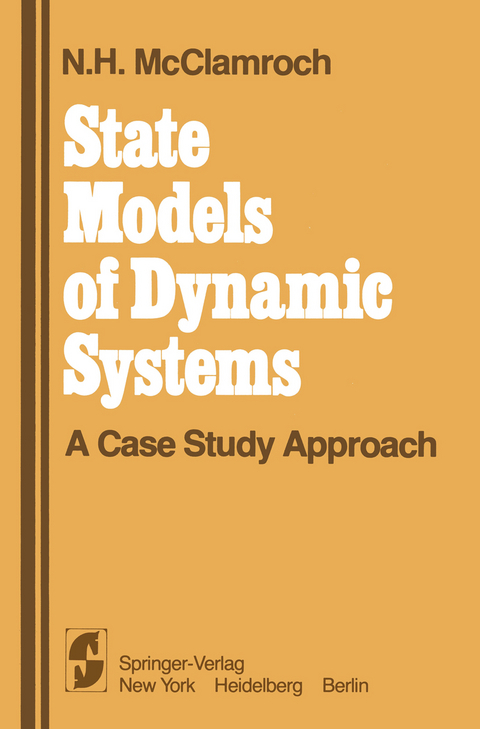
State Models of Dynamic Systems
Springer-Verlag New York Inc.
978-1-4612-6089-9 (ISBN)
I Modeling Dynamic Systems.- Modeling Philosophy.- Some Physical Principles.- State Models.- Some Systems Concepts.- Use of State Models.- II First Order Linear State Models.- Some Systems Theory.- Case Study 2–1: Radioactive Decay of Cesium.- Case Study 2–2: Temperature in a Building.- Case Study 2–3: An RC Circuit.- Exercises.- III Second Order Linear State Models.- Some Systems Theory.- Case Study 3–1: Ingestion and Metabolism of a Drug.- Case Study 3–2: Mixing of a Salt Solution.- Case Study 3–3: DC Motor.- Case Study 3–4: A Bridged-T-Filter.- Exercises.- IV Higher Order Linear State Models.- Some Systems Theory.- Case Study 4–1: Reduction of Limestone by Heating.- Case Study 4–2: Vertical Ascent of a Deep Sea Diver.- Case Study 4–3: A Speedometer Mechanism.- Case Study 4–4: Automobile Suspension System.- Case Study 4–5: Magnetic Loudspeaker.- Exercises.- V First Order Nonlinear State Models.- Some Systems Theory.- Case Study 5–1: Management of a Fisheries Resource.- Case Study 5–2: Liquid Level in a Leaky Tank.- Case Study 5–3: High Temperature Oven.- Case Study 5–4: Circuit with Diode.- Exercises.- VI Second Order Nonlinear State Models.- Some Systems Theory.- Case Study 6–1: Motion of a Boat Crossing a River.- Case Study 6–2: Spread of an Epidemic.- Case Study 6–3: Tunnel-Diode Circuit.- Case Study 6–4: Underwater Launch of a Rocket.- Case Study 6–5: A Study of Blood Sugar and Insulin Levels with Application to Diabetes.- Exercises.- VII Higher Order Nonlinear State Models.- Some Systems Theory.- Case Study 7–1: Continuous Flow Stirred Tank Chemical Reactor.- Case Study 7–2: A Hot Air Balloon.- Case Study 7–3: Motion of a Rocket Near Earth.- Case Study 7–4: Electrostatic Microphone.- Exercises.- VIII OtherDifferential State Models.- Case Study 8–1: Feedback Control of the Liquid Level in a Tank.- Case Study 8–2: Automatic Regulation of Temperature in a Building.- Case Study 8–3: Sampled Control of a Field Actuated Motor.- Exercises.- IX Discrete Time and State Models.- Case Study 9–1: Occupancy in a Hospital Unit.- Case Study 9–2: An Inventory Model.- Case Study 9–3: Neuron Model.- Case Study 9–4: Coin Operated Dispenser.- Case Study 9–5: A Binary Communications Channel.- Case Study 9–6: Discrete Population Model.- Exercises.- Appendix A Units, Dimensions, and Conversion Factors.- Appendix B Laplace Transforms.- Appendix C Routh-Hurwitz Criteria.- Appendix D Linear Approximations.- Appendix E Digital Computer Simulation and CSMP.- References.
| Zusatzinfo | VIII, 248 p. |
|---|---|
| Verlagsort | New York, NY |
| Sprache | englisch |
| Maße | 155 x 235 mm |
| Themenwelt | Sachbuch/Ratgeber ► Natur / Technik ► Garten |
| Informatik ► Theorie / Studium ► Künstliche Intelligenz / Robotik | |
| Naturwissenschaften ► Physik / Astronomie ► Allgemeines / Lexika | |
| Technik ► Elektrotechnik / Energietechnik | |
| Technik ► Maschinenbau | |
| Schlagworte | Dynamisches System • Modell (Math.) • Systems |
| ISBN-10 | 1-4612-6089-2 / 1461260892 |
| ISBN-13 | 978-1-4612-6089-9 / 9781461260899 |
| Zustand | Neuware |
| Haben Sie eine Frage zum Produkt? |
aus dem Bereich


